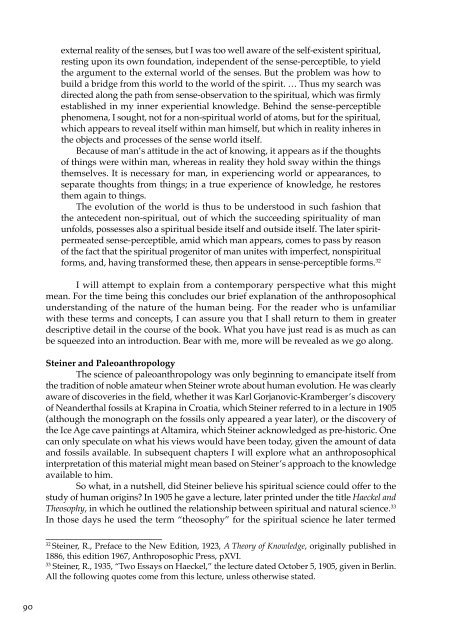The Spirit in Human Evolution - Waldorf Research Institute
The Spirit in Human Evolution - Waldorf Research Institute
The Spirit in Human Evolution - Waldorf Research Institute
Create successful ePaper yourself
Turn your PDF publications into a flip-book with our unique Google optimized e-Paper software.
external reality of the senses, but I was too well aware of the self-existent spiritual,<br />
rest<strong>in</strong>g upon its own foundation, <strong>in</strong>dependent of the sense-perceptible, to yield<br />
the argument to the external world of the senses. But the problem was how to<br />
build a bridge from this world to the world of the spirit. … Thus my search was<br />
directed along the path from sense-observation to the spiritual, which was firmly<br />
established <strong>in</strong> my <strong>in</strong>ner experiential knowledge. Beh<strong>in</strong>d the sense-perceptible<br />
phenomena, I sought, not for a non-spiritual world of atoms, but for the spiritual,<br />
which appears to reveal itself with<strong>in</strong> man himself, but which <strong>in</strong> reality <strong>in</strong>heres <strong>in</strong><br />
the objects and processes of the sense world itself.<br />
Because of man’s attitude <strong>in</strong> the act of know<strong>in</strong>g, it appears as if the thoughts<br />
of th<strong>in</strong>gs were with<strong>in</strong> man, whereas <strong>in</strong> reality they hold sway with<strong>in</strong> the th<strong>in</strong>gs<br />
themselves. It is necessary for man, <strong>in</strong> experienc<strong>in</strong>g world or appearances, to<br />
separate thoughts from th<strong>in</strong>gs; <strong>in</strong> a true experience of knowledge, he restores<br />
them aga<strong>in</strong> to th<strong>in</strong>gs.<br />
<strong>The</strong> evolution of the world is thus to be understood <strong>in</strong> such fashion that<br />
the antecedent non-spiritual, out of which the succeed<strong>in</strong>g spirituality of man<br />
unfolds, possesses also a spiritual beside itself and outside itself. <strong>The</strong> later spiritpermeated<br />
sense-perceptible, amid which man appears, comes to pass by reason<br />
of the fact that the spiritual progenitor of man unites with imperfect, nonspiritual<br />
forms, and, hav<strong>in</strong>g transformed these, then appears <strong>in</strong> sense-perceptible forms. 32<br />
I will attempt to expla<strong>in</strong> from a contemporary perspective what this might<br />
mean. For the time be<strong>in</strong>g this concludes our brief explanation of the anthroposophical<br />
understand<strong>in</strong>g of the nature of the human be<strong>in</strong>g. For the reader who is unfamiliar<br />
with these terms and concepts, I can assure you that I shall return to them <strong>in</strong> greater<br />
descriptive detail <strong>in</strong> the course of the book. What you have just read is as much as can<br />
be squeezed <strong>in</strong>to an <strong>in</strong>troduction. Bear with me, more will be revealed as we go along.<br />
Ste<strong>in</strong>er and Paleoanthropology<br />
<strong>The</strong> science of paleoanthropology was only beg<strong>in</strong>n<strong>in</strong>g to emancipate itself from<br />
the tradition of noble amateur when Ste<strong>in</strong>er wrote about human evolution. He was clearly<br />
aware of discoveries <strong>in</strong> the field, whether it was Karl Gorjanovic-Kramberger’s discovery<br />
of Neanderthal fossils at Krap<strong>in</strong>a <strong>in</strong> Croatia, which Ste<strong>in</strong>er referred to <strong>in</strong> a lecture <strong>in</strong> 1905<br />
(although the monograph on the fossils only appeared a year later), or the discovery of<br />
the Ice Age cave pa<strong>in</strong>t<strong>in</strong>gs at Altamira, which Ste<strong>in</strong>er acknowledged as pre-historic. One<br />
can only speculate on what his views would have been today, given the amount of data<br />
and fossils available. In subsequent chapters I will explore what an anthroposophical<br />
<strong>in</strong>terpretation of this material might mean based on Ste<strong>in</strong>er’s approach to the knowledge<br />
available to him.<br />
So what, <strong>in</strong> a nutshell, did Ste<strong>in</strong>er believe his spiritual science could offer to the<br />
study of human orig<strong>in</strong>s? In 1905 he gave a lecture, later pr<strong>in</strong>ted under the title Haeckel and<br />
<strong>The</strong>osophy, <strong>in</strong> which he outl<strong>in</strong>ed the relationship between spiritual and natural science. 33<br />
In those days he used the term “theosophy” for the spiritual science he later termed<br />
_________________________<br />
32<br />
Ste<strong>in</strong>er, R., Preface to the New Edition, 1923, A <strong>The</strong>ory of Knowledge, orig<strong>in</strong>ally published <strong>in</strong><br />
1886, this edition 1967, Anthroposophic Press, pXVI.<br />
33<br />
Ste<strong>in</strong>er, R., 1935, “Two Essays on Haeckel,” the lecture dated October 5, 1905, given <strong>in</strong> Berl<strong>in</strong>.<br />
All the follow<strong>in</strong>g quotes come from this lecture, unless otherwise stated.<br />
90
















